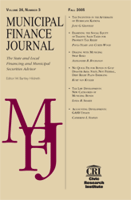U.S. Municipal Rating Transitions and Defaults, 1986–2003
Author: Colleen Woodell.; William Montrone.; Brooks Brady.
Source: Volume 24, Number 04, Winter 2004 , pp.49-77(29)

< previous article |next article > |return to table of contents
Abstract:
The U.S. public finance market has traditionally possessed significant stability and sound credit characteristics. The results of Standard & Poor’s Ratings Services public finance default and ratings transition studies continue to provide statistical support for this view. Given the nature of public finance, it should come as no surprise that unenhanced debt (i.e., debt obligations not supported by financial guarantees, structuring techniques, multiple-party features or other external credit support) rated by Standard & Poor’s shows significant credit stability throughout a broad range of events ranging from changing economic times, federal government mandates, tax reform measures, and any number of influences on general credit. The study tracked the behavior of unenhanced rated debt obligations over the 1986–2003 period; aggregate and sector data are now also available and are included in this study. The public-finance-wide conclusions and the aggregated tables focus on unenhanced debt and exclude pub lic finance structured and housing debt, since debt obligations issued in those sectors typically include some form of enhancement. In the sector breakdowns, housing information is shown on an issue, not issuer, basis, so methodologically cannot be combined with the other public finance data.Keywords:
Affiliations:
1: Standard & Poor’s Rating Services; 2: Standard & Poor’s Rating Services; 3: Standard & Poor’s Rating Services.